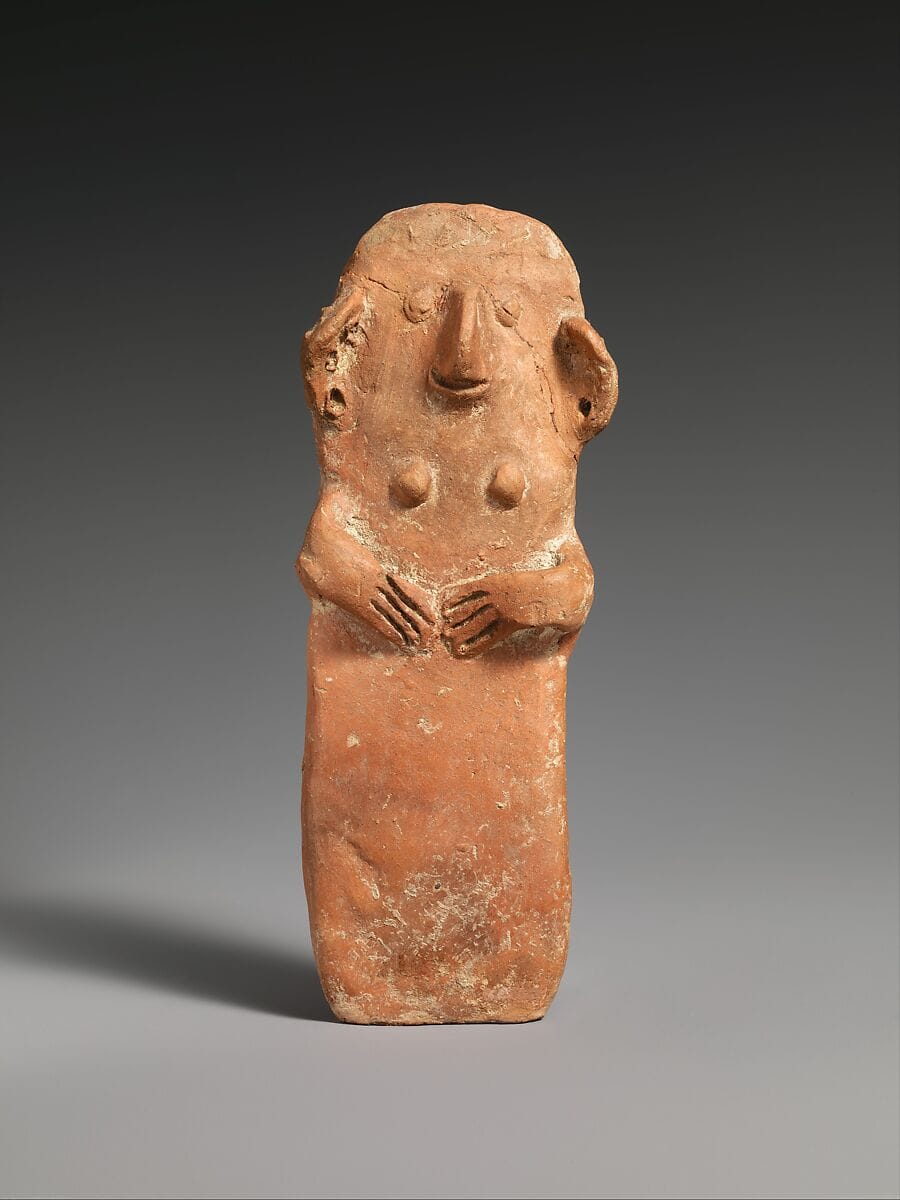
The Enigmatic Plank-Shaped Figures of Ancient Cyprus
Alexis Drakopoulos
Alexis Drakopoulos is a Greek Cypriot Machine Learning Engineer working in Financial Crimes. He is passionate about Archeology and making it accessible to everyone. About Me.
In the Middle Bronze Age, a captivating tradition emerged on the island of Cyprus: the creation of large, elaborate terracotta figures discovered mainly in tombs. While the meaning of these enigmatic figures remains uncertain, examining their style, archaeological context, and the wider social backdrop of the time offers tantalizing clues about the beliefs and preoccupations of the ancient society that crafted them.
March 8, 2024
Archeology, Ceramics, History
Sometime around 2000 BC, a curious tradition emerged: the creation of large terracotta figures depicting elaborately dressed humans. Discovered primarily in tombs, these compelling and somewhat enigmatic figures have fascinated archaeologists for over a century. Yet despite intensive study, many basic questions about them remain stubbornly unresolved. What did they represent? Who made them and for what purpose? And what can they tell us about the society that produced them?
The figures first came to light in 1913 during excavations at Lapithos on the north coast of Cyprus. Cut from flat slabs of clay and measuring up to 35 centimeters high, they depict stylized human forms adorned with intricate details—facial features, headdresses, necklaces, earrings, and decorated garments. Most portray a single standing figure, but some show a mother holding an infant, and others feature two or even three heads sprouting from a single body.
British archaeologists working in colonial Cyprus greeted these finds with polite befuddlement, classifying them simply as depictions of "ladies" and speculating they might represent a "mother goddess." But as more examples surfaced over the following decades, from Lapithos and a handful of other sites, it became clear the figures fit no easy interpretation.
Gender has been a focus of scholarly debates. While some see the Lapithos figures as clearly female based on occasional depictions of breasts, others argue gender signifiers are absent or ambiguous in many cases. Proposals have run the gamut—that the figures depict only women and reflect a matriarchal society, or both women and men and symbolize the family unit, or that they are essentially gender neutral.
There is also little agreement on who or what they represent. Various archaeologists have suggested the figures depict a fertility goddess, a divine ancestress, elite women of the community, or symbolic representations of social roles. On the stranger end of the spectrum, some propose the multiheaded figures are whimsical "magical monsters" or talismans used to magically induce the birth of twins.
So what are we to make of these confounding figures? One productive approach is to examine where and when they appear. The figures are not found uniformly across Cyprus, but cluster at a few sites, chiefly Lapithos. And they emerge suddenly around 2000 BC, flourish for a few centuries, then vanish. This restricted distribution in space and time provides important clues.
Careful examination of find contexts also yields insights. At Lapithos, figures were deposited in lavish tombs alongside prestige goods like gold jewelry and masses of copper—in an era when Cyprus was the major source of this valuable metal. In some cases, figures are found in special positions, such as placed under skulls or arranged on "altars" surrounded by ritual vessels. This hints they played a role in funerary ceremonies and were perhaps seen as conduits for supernatural forces.
The broader social context is also revealing. When the distinctive Lapithos figures first appear, the site was undergoing a period of rapid growth and prosperity, emerging as the island's dominant center for copper production and export. This economic boom coincided with changing burial customs, as certain families began amassing unprecedented wealth and burying their dead in increasingly extravagant tombs.
Considered in this light, the Lapithos figures appear to be entangled with an escalating competition for status and power among elite groups. By burying their dead with ornate idols and grave offerings, leading families may have sought to assert their importance and legitimize their authority through ties to ancestors and the divine.
The iconography of the figures supports this idea. Rather than highlighting traits of fertility or sexuality, they focus visual emphasis on markers of wealth and status like elaborate hairstyles, headdresses, jewelry and ornamented garments. In essence, they transpose the trappings of elite identity in life onto idealizing images meant to memorialize the dead.
Fascinatingly, the Lapithos figures seem to have been made exclusively at the site and only later "trickled down" to other areas through gift exchange or emulation. Archaeologists have found figures made of imported clays at smaller villages in the island's interior but also locally-made imitations of inferior quality—suggesting the Lapithos figures were already famous across the island and seen as prestige items.
The multi-headed figures add an extra wrinkle of mystery. By combining human and non-human elements, they blur the line between the real and fantastical, the physical and supernatural. They may represent beings that straddled different realms, such as revered ancestors or local deities. Alternatively, merging multiple individuals into a single figure could symbolize the social bonds of family or depict a person in different stages of life.
Ultimately, the Lapithos figures show how ancient communities used art and ritual to grapple with changing social realities. Faced with growing inequality, the people of Lapithos invested certain images with cultural power and meaning—as idealizations of identity, links to the ancestral past, and possibly conduits to divine realms.
That their exact meaning still eludes us is a testament to their complexity. But by piecing together clues from across the archaeological record, we can at least begin to sketch the outlines of the distant world that birthed these silent and enigmatic envoys from the past. And in that process of inquiry, we move a little closer to understanding the hopes, beliefs and ideals of a society that vanished long ago but still speaks to us through its arresting material remains.




